Today Current Affairs: 23rd June 2021 for UPSC IAS exams, State PSC exams, SSC CGL, State SSC, RRB, Railways, Banking Exam & IBPS, etc
Table of Contents
National Food Security Act (NFSA), 2013:

Centre amends Food Security rules to prevent ration leakage, corruption.
- The government said that this amendment has been made as an attempt to take forward the reform process envisaged under Section 12 of the National Food Security Act (NFSA), 2013 by way of improving the transparency of the operation of the Targeted Public Distribution System (TPDS) under NFSA.
- This amendment aims to ensure the right quantity to beneficiaries in the distribution of subsidised food grains under the National Food Security Act (NFSA), 2013 as per their entitlement.
- It also incentivizes states who have been using ePoS efficiently and encourages states to improve efficiency in ePoS operations and generate savings.
The amendment:
- According to the amendment, states that are operating their ePoS devices judiciously and are able to generate savings from the additional margin of Rs 17 per quintal can now utilise the savings for purchase, operations and maintenance of electronic weighing scales and their integration with the point of sale devices.
Special Procedures Branch Of The Human Rights Council:

Permanent Mission of India to the United Nations Office and other International Organizations in Geneva has responded the concerns raised by Special Procedures Branch of the Human Rights Council regarding India’s Information Technology (Intermediary Guidelines and Digital Media Ethics Code) Rules, 2021.
- The term ‘special procedures’ refers to the list of mechanisms established by the Human Rights Council to report and advise on human rights from a thematic and country-specific perspective.
- Special procedures cover all human rights: civil, cultural, economic, political and social as well as issues relating to specific groups.
- Special procedures mandate-holders are either an individual (called a Special Rapporteur (SR) or Independent Expert (IE)) or a Working Group (WG) of five members.
- Mandate holders serve in their personal capacities, they are not UN staff and do not receive salaries or other financial remuneration for their work.
- A mandate-holder’s tenure in a given function, whether it is a thematic or country mandate, is limited to a maximum of six years.
- They are non-paid and elected for 3-year mandates that can be reconducted for another three years.
- Mandate holders are appointed by the Human Rights Council and their work is supported by the OHCHR.
- As part of their mandates, special procedures examine, advise and publicly report on human rights issues and situations.
- Special procedures report annually to the Human Rights Council; the majority of the mandates also report annually to the General Assembly.
Recusal Of Judges:
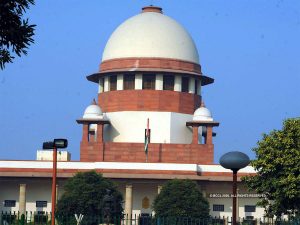
Two Supreme Court (SC) judges have recused themselves from hearing cases relating to West Bengal.
- Recusal is the act of abstaining from participation in an official action such as a legal proceeding due to a conflict of interest of the presiding court official or administrative officer.
Reason for Recusal:
- When there is a conflict of interest, a judge can withdraw from hearing a case to prevent creating a perception that he carried a bias while deciding the case.
- The conflict of interest can be in many ways such as:
- Having a prior or personal association with a party involved in the case.
- Appeared for one of the parties involved in a case.
- Ex parte communications with lawyers or non-lawyers.
- An appeal is filed in the SC against a judgement of a High Court (HC) that may have been delivered by the SC judge when he was in the HC.
- In a matter of a company in which he holds shares unless he has disclosed his interest and there is no objection to it.
- The practice stems from the cardinal principle of due process of law that nobody can be a judge in her own case.
- Any interest or conflict of interest would be a ground to withdraw from a case since a judge has a duty to act fair.
New Doppler Radars In Maharashtra: IMD:

The India Meteorological Department (IMD) announced that it will install seven new doppler radars in Maharashtra, including Mumbai in 2021.
- In January 2021, the Union Minister for Earth Sciences commissioned two of the ten indigenously built X-Band Doppler Weather Radars (DWR) to closely monitor the weather changes over the Himalayas.
India Meteorological Department:
- It is an agency of the Ministry of Earth Sciences, established in 1875.
- It is the principal agency responsible for meteorological observations, weather forecasting and seismology.
- Doppler radars of varying frequencies — S-band, C-band and X-band — are commonly used by the IMD to detect and track the movement of weather systems, cloud bands and gauge rainfall over its coverage area of about 500 km.
- Four X-band and one C-band radar will be deployed over Mumbai. In addition, Ratnagiri will get a new C-band and Vengurla will get an X-band radar, each of which will operate for multiple purposes.
Radar (Radio Detection and Ranging):
- It is a device which uses electromagnetic waves in the microwaves region to detect location (range & direction), altitude, intensity and movement of moving and non-moving objects.
- Doppler Radar:
- It is a specialized radar that uses the Doppler effect to produce velocity data about objects at a distance.
- Doppler effect: When the source and the signal are in relative motion to each other there is a change in the frequency observed by the observer.
- If they are moving closer, frequency increases and vice versa.
Increase In Direct Tax Collections:

India’s direct tax collections in the first two and a half months (April – June) of 2021-22 stand at nearly Rs. 1.86 lakh crore, which is double the collections over the same period of last year that was affected by the national lockdown.
- The collections last year over the same period were Rs. 92,762 crore.
- Surge in Direct Tax Collections: It includes Corporation Tax collections of Rs. 74,356 crore and Personal Income Tax inflows, which include the Security Transaction Tax of Rs. 1.11 lakh crore.
- The jump in the direct tax collections reflects healthy exports and a continuation of various industrial and construction activities.
- It is expected that GDP (Gross Domestic Product) will record a double-digit expansion in Quarter 1 of 2021-22.
Ebola Virus:

The World Health Organisation (WHO) has declared that the Ebola outbreak, that started in February 2021 in Guinea, is over now.
- In its first deadly wave in 2013-2016, the Ebola outbreak killed 11,300 people, mostly in Guinea, Sierra Leone and Liberia.
- The WHO in its list of “Ten threats to global health in 2019” also included Ebola.
About Ebola Virus Disease (EVD):
- EVD, formerly known as Ebola haemorrhagic fever, is transmitted to people from wild animals and spreads in the human population through human to human transmission.
- Ebola virus was first discovered in 1976 near the Ebola River in what is now the Democratic Republic of Congo.
- Transmission: Fruit bats of the Pteropodidae family are natural Ebola virus hosts.
- Animal to Human Transmission: Ebola is introduced into the human population through close contact with the blood, secretions, organs or other bodily fluids of infected animals such as fruit bats, chimpanzees, gorillas, monkeys, forest antelope or porcupines found ill or dead or in the rainforest.
- Human-to-Human Transmission: Ebola spreads via direct contact (through broken skin or mucous membranes) with:
Blood or body fluids of a person who is sick with or has died from Ebola. - Objects that have been contaminated with such body fluids (like blood, feces, vomit).
- Symptoms:
- These can be sudden and include: Fever, Fatigue, Muscle pain, Headache, Sore throat, Vomiting, Diarrhoea, Symptoms of impaired kidney and liver function, in some cases, both internal and external bleeding.
- It can be difficult to clinically distinguish Ebola from other infectious diseases such as malaria, typhoid fever, and meningitis but confirmation that symptoms are caused by Ebola virus infection are made using the following.
India-US: PASSEX:

Indian naval ships will join maritime patrol and other aircraft to participate in a Passage Exercise or PASSEX with the US Navy’s Ronald Reagan Carrier Strike Group during its transit through Indian Ocean Region (IOR).
- A passage exercise is normally undertaken whenever an opportunity arises, in contrast to pre-planned maritime drills.
- Earlier, the Indian Navy had also conducted similar PASSEXs with the Japanese Navy and the French Navy.
- Indian Naval Ships Kochi and Teg along with P8I (maritime patrol aircraft) and (Indian ship based) MiG 29K aircraft are participating in the PASSEX.
- The Indian Naval warships along with aircraft from Indian Navy and Indian Air Force (IAF) will be engaged in joint multi-domain operations with the US Carrier Strike Group.
- The exercise is in the IAF’s Southern Air Command’s area of responsibility and the IAF forces will include Jaguars, Sukhoi-30 MKI fighters, Air-to-Air Refueller aircraft, Airborne Warning And Control System (AWACS) and Airborne Early Warning and Control (AEW&C).
- High tempo operations during the exercise include advanced air defence exercises, cross deck helicopter operations and anti-submarine exercises.
4th Tiger Reserve Of Rajasthan: Ramgarh Vishdhari Wildlife Sanctuary:
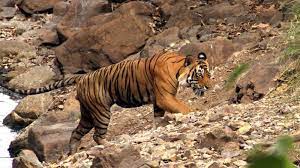
The Ramgarh Vishdhari wildlife sanctuary received a nod from the National Tiger Conservation Authority’s (NTCA) technical committee to become the 4th Tiger reserve of Rajasthan.
- This will be the 52nd Tiger Reserve of India.
- The Global Tiger Day, celebrated on 29th July, is an annual event marked to raise awareness about tiger conservation.
Ramgarh Vishdhari wildlife sanctuary:
- This Sanctuary is located at a distance of 45 Km from Bundi City on Bundi-Nainwa Road near Village Ramgarh, District Bundi, Rajasthan.
- It was notified in the Year 1982 and is spread over an area of 252.79 Sq. Km.
- The total area of 1,017 sq. km has been identified as the reserve area comprising two forest blocks of Bhilwara, territorial forest block of Bundi and Indargarh, which falls under the buffer zone of Ranthambore Tiger Reserve (RTR).
- Its flora consists of Dhok, Khair, Salar, Khirni trees with some Mango and Ber trees.
- The Fauna consists of birds and animals like Leopard, Sambhar, Wild boar, Chinkara, Sloth bear, Indian Wolf, Hyena, Jackal, Fox, deer and Crocodile.
World’s 1st GM rubber sapling:
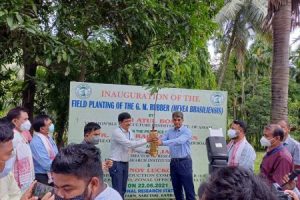
World’s first genetically modified (GM) rubber sapling was recently planted at the Rubber Board’s Sarutari research farm on the outskirts of Guwahati in Assam.
- It was developed at the Kerala-based Rubber Research Institute of India (RRII).
- With additional copies of the gene MnSOD (manganese-containing superoxide dismutase) inserted in it, the GM rubber is expected to tide over the severe cold conditions during winter, which is a major factor affecting the growth of rubber saplings.
- MnSOD gene used in the GM rubber was taken from the rubber plant itself.
Pygmy Hog:
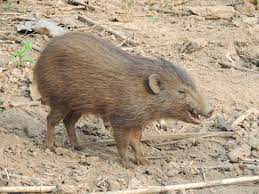
Eight captive-bred pygmy hogs, the world’s rarest and smallest wild pigs, were released in the Manas National Park of Assam.
- This is the second batch to have been reintroduced into the wild under the Pygmy Hog Conservation Programme (PHCP) in a year.
Pygmy Hog Conservation Programme (PHCP):
- The PHCP is a collaboration among Durrell Wildlife Conservation Trust of UK, Assam Forest Department, Wild Pig Specialist Group of International Union for Conservation of Nature (IUCN) and Ministry of Environment, Forest and Climate Change.
- It is currently being implemented by NGOs – Aaranyak and EcoSystems India.
- Conservation of pygmy hog was initiated by noted naturalist Gerald Durrell and his trust in 1971.
- The pygmy hog was brought back from near-extinction by the partnership effort, and now moving towards the establishment of a population across the entire range.
- Six hogs were captured from the Bansbari range of the Manas National Park in 1996 for starting the breeding programme.
- The reintroduction programme began in 2008 with the Sonai-Rupai Wildlife Sanctuary, Orang National Park and Bornadi Wildlife Sanctuary, all of them are in Assam.
- By 2025, the PHCP plans to release 60 pygmy hogs in Manas.
About Pygmy Hog:
- Scientific Name: Porcula Salvania
- It is one of the very few mammals that build its own home, or nest, complete with a ‘roof’.
- It is also an indicator species. Its presence reflects the health of its primary habitat, the tall, wet grasslands of the region.
- As the population is estimated at less than 250 mature individuals, it is listed as Endangered on the IUCN Red List.
Great Barrier Reef:

The UNESCO World Heritage Committee has recommended that the Australia’s Great Barrier Reef should be added to a list of “in danger” World Heritage Sites.
- Placement on the ‘‘in-danger list’’ is not considered a sanction.
- Some nations have their sites added to gain international attention and help to save them.t
- It was recommended to add to the list because of the impact of climate change.
- Despite Reef 2050, the coral reef ecosystem has suffered three major bleaching events since 2015 due to severe marine heatwaves.
- The Reef 2050 Long-Term Sustainability Plan is the Australian and Queensland Government’s overarching framework for protecting and managing the Great Barrier Reef by 2050.
- When corals face stress by changes in conditions such as temperature, light, or nutrients, they expel the symbiotic algae zooxanthellae living in their tissues, causing them to turn completely white. This phenomenon is called coral bleaching.
- Marine heatwave is an event of anomalous warm sea surface temperatures (SST) from several days to years.
About Great Barrier Reef:
- It is the world’s most extensive and spectacular coral reef ecosystem composed of over 2,900 individual reefs and 900 islands.
- The reef is located in the Coral Sea (North-East Coast), off the coast of Queensland, Australia.
- It can be seen from outer space and is the world’s biggest single structure made by living organisms.
- This reef structure is composed of and built by billions of tiny organisms, known as coral polyps.
- They are made up of genetically identical organisms called polyps, which are tiny, soft-bodied organisms. At their base is a hard, protective limestone skeleton called a calicle, which forms the structure of coral reefs.
- These polyps have microscopic algae called zooxanthellae living within their tissues. The corals and algae have a mutualistic (symbiotic) relationship.
’Divyangta Khel Kendras’:
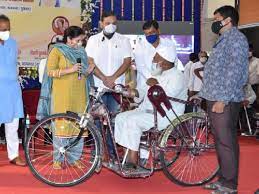
Union minister for Social Justice and Empowerment Thaawarchand Gehlot announced establishment of five ’Divyangta Khel Kendras’ in different parts of country.
- They have been established while looking at the interest towards the sports among the Divyangjan of the country and their good performance in Paralympics.
- He also distributed aids and assistive devices to ‘Divyangjan’ under the Assistance to Disabled Persons (ADIP) Scheme of the Ministry of Social Justice and Empowerment.
- ADIP is one of the most popular schemes for providing assistive aids and appliance to Divyangjans.
- It is organized by Artificial Limbs Manufacturing Corporation of India (ALIMCO), a Public Sector Undertaking under the Department of Empowerment of Persons with Disabilities (DEPwD), Ministry of Social Justice and Empowerment.
- The Corporation started manufacturing artificial aids in 1976.




